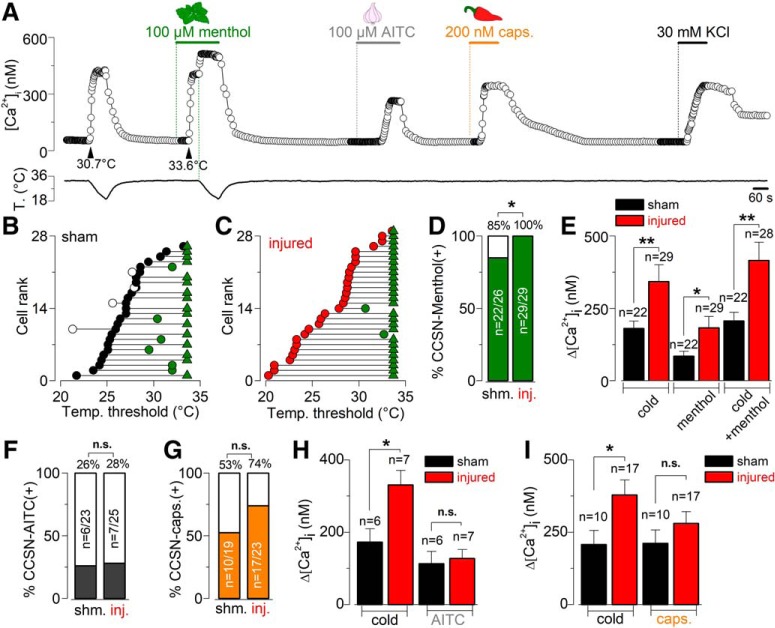Figure 3.
Evaluation of the responses of CCSNs from sham and injured mice to cold and chemical agonists of thermo-TRP channels. A, Protocol in Ca2+ imaging used to evaluate the responses of CCSNs to cold, menthol (100 μm), cold plus menthol (TRPM8 activators), AITC (100 μm; TRPA1 agonist) and capsaicin (200 nm; TRPV1 agonist). This trace corresponds to a CCSN from a sham animal. B, C, Dot plots of the effect of 100 μm menthol on the cold-evoked temperature threshold in 26 control CCSNs (black circles) and 29 injured CCSNs (red circles). These neurons have been plotted according to the initial temperature threshold in control solution from lowest to highest temperatures. The shift in thermal threshold in menthol-sensitive neurons is represented by green circles, and green triangles indicate the neurons that respond to menthol at 34°C. The thermal threshold of menthol-insensitive CCSNs is represented by white circles. D, Bar graph showing the percentage of menthol-sensitive (green) and menthol insensitive (white) CCSNs in both populations (*p = 0.0438, Fisher's exact test). E, Bar graph summarizing the mean amplitude of cold-, menthol-, and cold plus menthol-induced responses of CCSNs from control (black) and injured (red) mice (cold: t(49) = 3.103, **p = 0.0031, unpaired t test; menthol and cold plus menthol: t(44) = 2.484, *p = 0.0169 and t(46) = 3.161, **p = 0.0028 respectively; unpaired t test with Welch's correction). F, G, Bar graphs showing the percentage of the AITC-sensitive (gray) and AITC-insensitive (white) and the capsaicin-sensitive (orange) and capsaicin-insensitive populations (white) of CCSNs in both groups (n.s. p = 1.0000 (AITC) and p = 0.2023 (Caps), Fisher's exact test). H, I, Bar graphs summarizing the mean amplitude of cold- and AITC-induced responses and cold- and capsaicin-induced responses in CCSNs from sham (black bar) and injured (red black) groups respectively (In H, t(11) = 2.304, *p = 0.0417, and t(11) = 0.1762, n.s. p = 0.8633; In I, t(25) = 2.388, *p = 0.0247, and t(25) = 1.280, n.s. p = 0.2123; unpaired t test).

